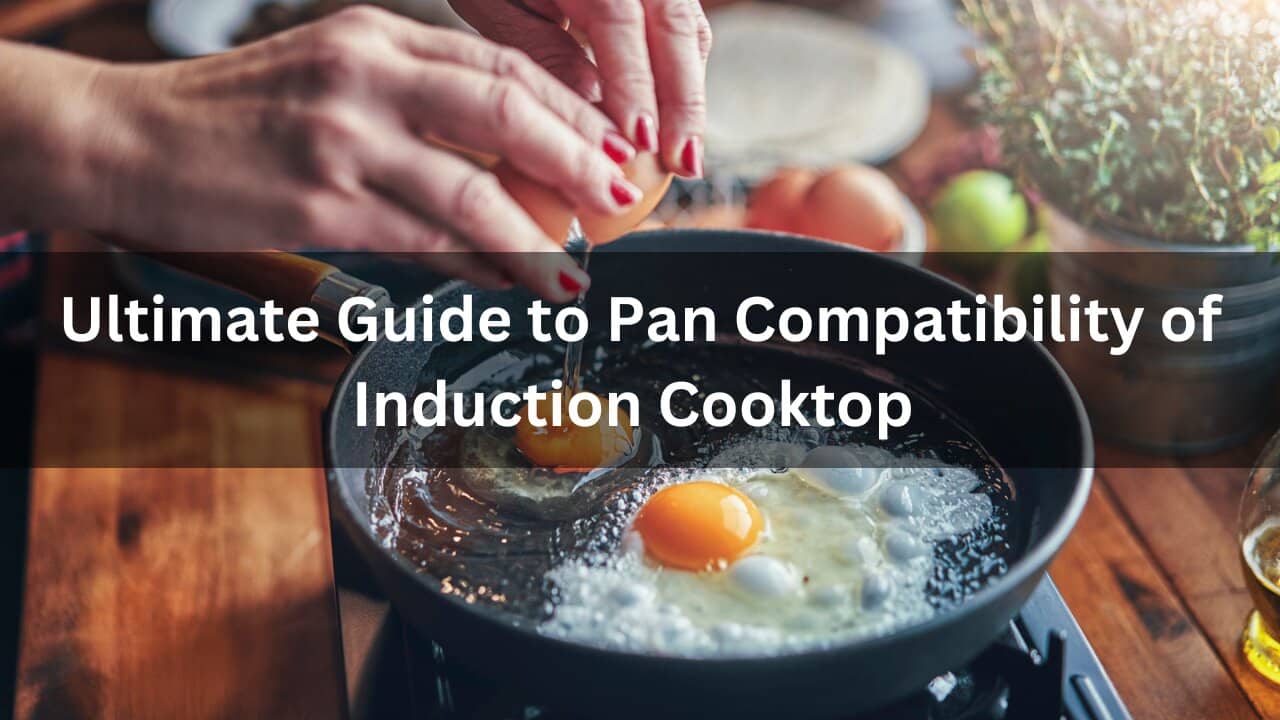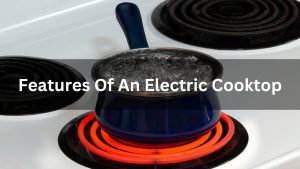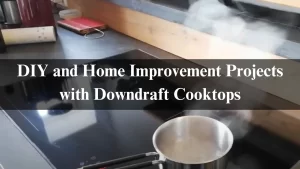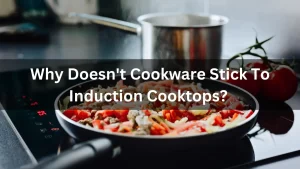Welcome to the Ultimate Guide to Pan Compatibility of Induction Cooktops in 2024! If you’re navigating the world of induction cooking, understanding which pans are compatible with your induction cooktop is crucial for achieving optimal cooking performance. Induction cooktops are known for their precision, efficiency, and safety but require specific cookware to work effectively.
This comprehensive guide delves into everything you need about pan compatibility, from the science behind induction cooking to detailed insights on which materials work best. Whether upgrading your kitchen or simply optimizing your current setup, you’ll discover how to choose the right cookware to maximize the benefits of your induction cooktop. Get ready to unlock the full potential of your induction stove with expert tips and practical advice tailored for 2024.
Table of Contents
Understanding Induction Cooking
Induction cooking operates on a fascinating principle of magnetism. Unlike traditional gas and electric stoves, Unlike traditional stoves that rely on flames or heating elements, induction cooktops use electromagnetic fields to generate heat directly within the cookware.
When you place a ferrous pot or pan on an induction surface, it activates the magnetic field. This causes atoms in the metal to vibrate, producing heat almost instantly. The result? Cooking is faster and more efficient.
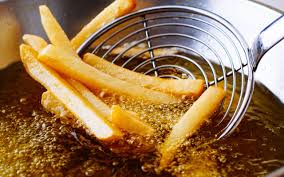
Another key benefit is precision control over temperature settings. With just a touch, you can adjust temperatures rapidly without waiting for burners to cool down or heat up.
Safety is another advantage worth noting. Since the cooktop remains relatively cool while cooking occurs only in the pan, there’s less risk of burns or accidental fires—making it ideal for busy kitchens with curious hands!
How Induction Cooking Works
Induction cooking is a method that uses a copper coil underneath the cooking surface to generate electromagnetic energy. This energy transfers directly to your cookware, heating it to cook food. The cooktop remains cool, offering efficient, precise, and safe cooking.
Why Don’t Some Pans Work on Induction?
Some pans don’t work on induction cooktops because they are not made of ferrous (magnetic) materials. Induction cooking relies on electromagnetic energy, which requires cookware to be magnetic to generate heat. Cookware types such as aluminum, aluminum-clad, copper, copper-clad, glass/ceramic, and some stainless steel products won’t work unless they attract and hold a magnet.
Are All Induction Pans Magnetic?
Not all induction pans are magnetic. A pan must have a magnetic and flat bottom to work on an induction cooktop. Induction cooktops use copper coils to directly generate heat from electric currents to your cookware. Some stainless steel pans are magnetic, while others are not, depending on their composition. To ensure compatibility, check if the pan is labeled as induction-compatible or test it with a magnet. If the magnet sticks to the pan, it should work on an induction cooktop.
Compatibility of Pans with Induction Stoves
Induction stoves generate a magnetic field requiring certain materials to function effectively. Not all pans are suitable for this type of cooking.
To ensure compatibility, look for cookware made from ferrous metals. Cast iron and stainless steel with magnetic properties are excellent choices. If a magnet sticks to the bottom of your pot or pan, it’s likely induction-friendly.
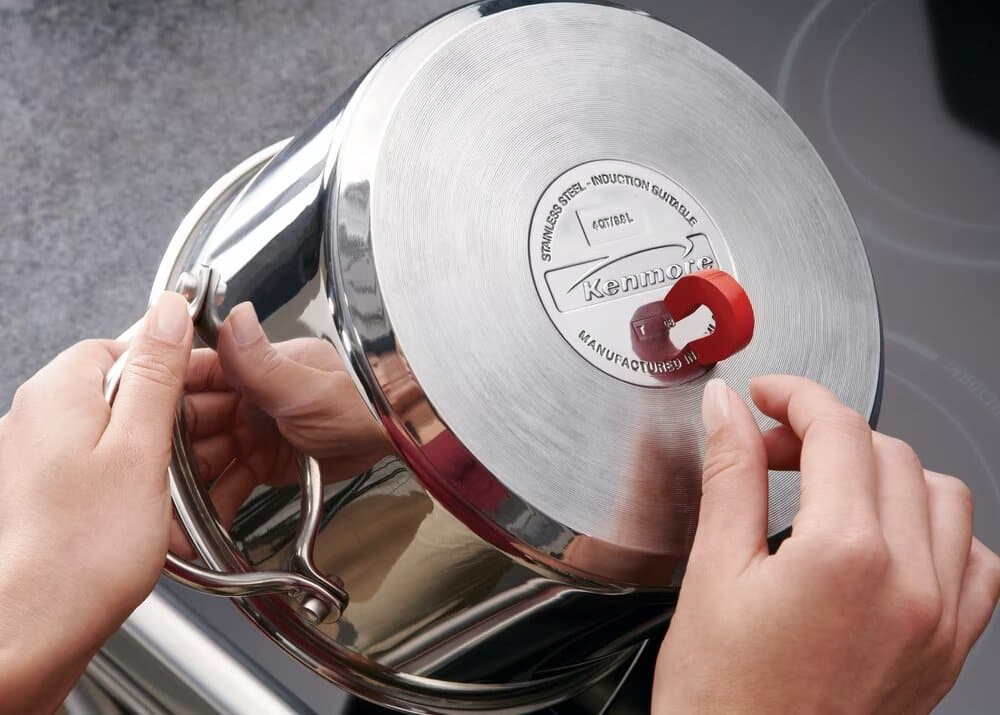
Avoid aluminum and glass cookware unless they have a special magnetic base for induction. These materials do not respond well to the electromagnetic fields created by induction cooktops.
Keep an eye on the flatness of your pan’s base as well. Uneven surfaces can hinder heat transfer, leading to poor cooking performance. A smooth and flat bottom is key for optimal efficiency when using an induction stove.
Do All Pans Work on Induction?
No, not all pans work on induction cooktops. Pots and pans must be made of a magnetic material, either iron or iron-based, such as steel, to be compatible. Induction heating excites the iron atoms in cookware, so there needs to be enough iron for the heat to occur.
How to Tell If a Pan Is Induction-Compatible
You can use a few simple methods to determine if a pan is induction-compatible. A quick way is the magnet test: grab a magnet from your fridge and place it against the bottom of the pan; if the magnet sticks, the pan will work on an induction cooktop. Look for an induction symbol (coil or zigzag lines) on the base or packaging of the pan, or check if the pan is labeled as “induction-ready” or “suitable for induction.” Materials like cast iron, carbon steel, and magnetic stainless steel are usually compatible, while pans made of aluminum, copper, or glass without a magnetic base are not. These tips help ensure you use the right cookware for your induction cooktop.

Can You Convert Normal Pans to Induction?
You can convert normal pans to work on induction cooktops using an induction converter disc. Non-induction cookware can still be used on an induction cooktop through these magnetic disks placed on the stove’s surface to attract heat. Place your non-induction cookware on top of the disc, which can heat up. The disc acts as a heat-conducting bridge between the cooktop and the non-compatible pan. However, using a converter disc can reduce efficiency, cause uneven heating, and may slow down cooking compared to using induction-compatible cookware directly.
Performance of Induction-Compatible Pans
Induction-compatible pans are designed for efficiency. They heat up quickly and distribute heat evenly across the cooking surface. This responsiveness means less time waiting for water to boil or oil to reach the right temperature.
The magnetic base of these pans plays a crucial role in performance. It connects them seamlessly with induction cooktops, ensuring rapid heating without hot spots. Cooking becomes more precise, allowing for better control over your culinary creations.
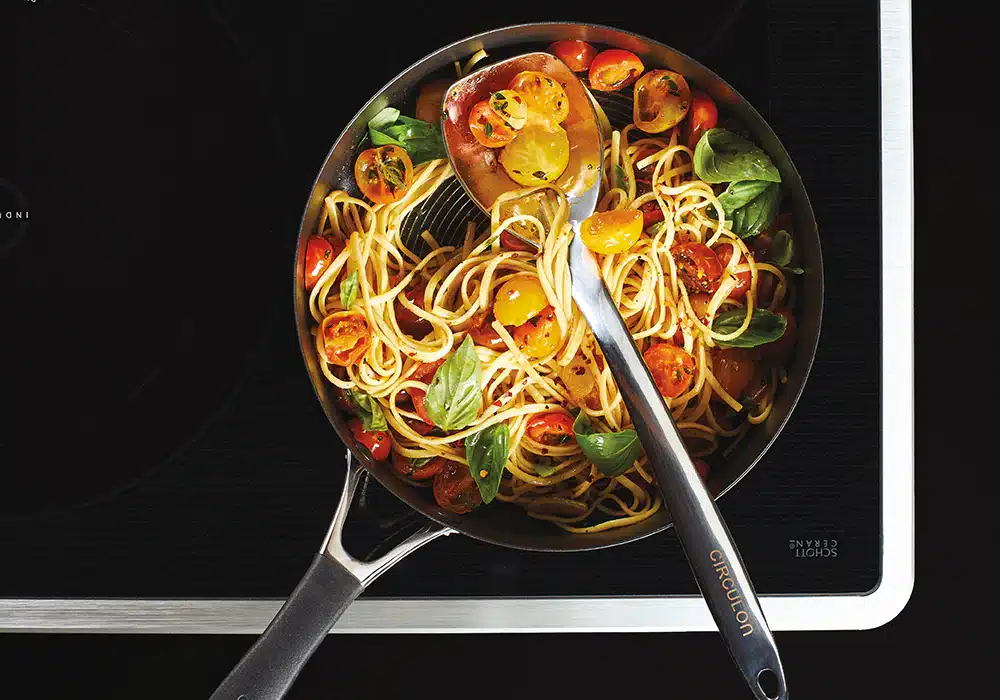
One of the standout features is how well they retain heat once warmed up. This characteristic is ideal for simmering sauces or keeping food at a steady temperature. Many home cooks appreciate this consistency in performance.
Durability also matters when it comes to induction cookware. Quality materials can endure frequent use while maintaining non-stick properties and structural integrity, making them reliable kitchen companions essential for everyday cooking.
Do Some Induction Pans Work Better Than Others?
Yes, some induction pans work better than others due to material, construction, and design differences. Induction efficiency depends on the magnetic permeability of the material. Cast iron is very good, but 432 stainless steel is even better due to its superior magnetic properties. Pans with a thick, multi-layered base (such as those with aluminum or copper cores sandwiched between magnetic stainless steel) tend to distribute heat more evenly and respond better to temperature changes. High-quality induction-compatible pans, like tri-ply or clad stainless steel, provide superior performance compared to thinner or cheaper alternatives, which may cause uneven heating. However, induction does not work on materials like copper and aluminum without a magnetic base.
What Type of Pan Is Best for Induction?
The best pans for induction are magnetic stainless steel (especially 432 stainless steel) and cast iron. Flat-bottomed pots or pans made from magnetic stainless steel, cast iron, enameled iron, and nickel work best on induction cooktops. Use quality cookware with heavy bottoms for better heat distribution and even cooking. Tri-ply or multi-clad stainless steel pans with magnetic bases and aluminum or copper cores are also excellent.
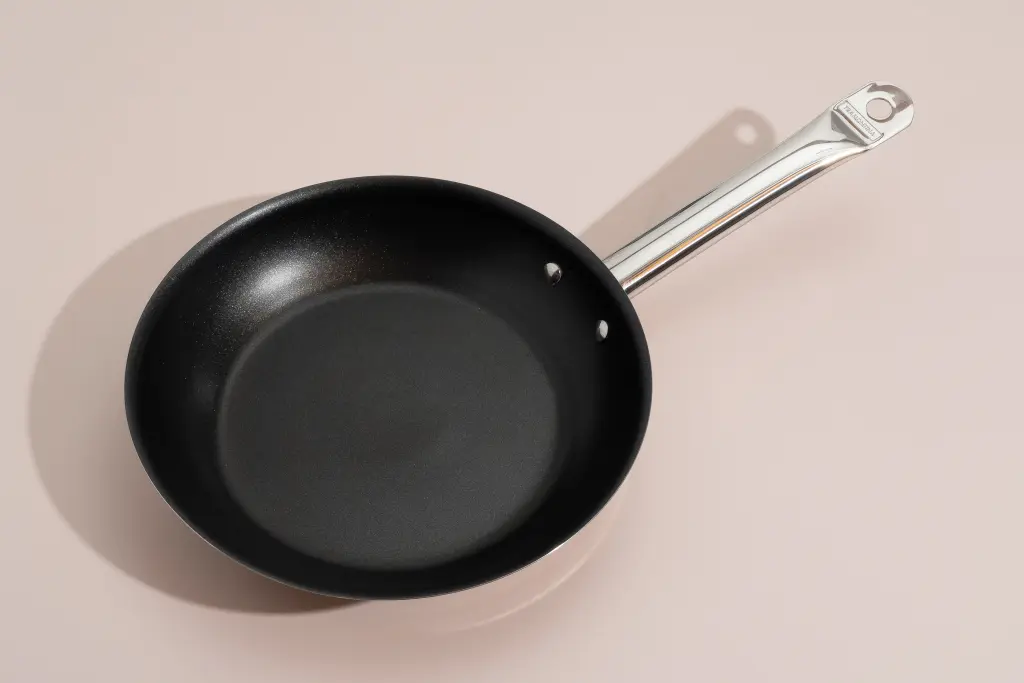
Can I Use Stainless Steel for Induction Cooking?
Yes, you can use stainless steel cookware on your electric stovetop. Induction stoves need cookware made from magnetic materials, such as stainless steel, while electric stoves can heat using coils or a smooth glass surface. Stainless steel’s compatibility with induction, electric, and gas stoves makes it versatile.
Is Stainless Steel OK on Induction Stoves?
Yes, stainless steel is OK on induction stoves if it is magnetic and has a flat bottom. Induction stoves require magnetic materials to generate heat, so ensure your stainless steel cookware has a magnetic base. Stainless steel with a high nickel content won’t work because nickel blocks the magnetic field. Like those from Whirlpool, stainless steel cookware with magnetic properties is ideal for induction cooktops. It’s also versatile for use on electric and gas stoves.
What Happens If You Use an Aluminum Pan on an Induction Hob?
Using an aluminum pan on an induction hob won’t work because aluminum is not magnetic. If it has that option, nothing will happen other than the possibility of an error code from the induction hob. Most induction hobs require a magnetic material to close the circuit, as aluminum, despite its high conductivity, doesn’t efficiently heat with the induction technology. An aluminum pan would need a magnetic base or an adapter to use it.
Choosing the Right Cookware
Selecting the right cookware for your induction cooktop can transform your cooking experience. Look for pans with a magnetic base, which is essential for compatibility with induction technology.
Stainless steel, cast iron, and some non-stick varieties are excellent choices. Each material offers distinct advantages in terms of heat retention and distribution. Consider how you typically cook when making your decision.
Weight also matters; heavier pans often provide better stability on an induction surface while promoting even heating.
Don’t forget to check the manufacturer’s specifications or labels on potential purchases. They will indicate whether the cookware is suitable for induction use.
Always think about size and shape to ensure a perfect fit on your stovetop’s burners—for optimal performance during meal preparation.
Best Kinds of Pots and Pans for Induction Hobs
The best pots and pans for induction hobs are:
- Cast Iron: Excellent heat retention and durability.
- Magnetic Stainless Steel: It has a magnetic base specifically designed for induction.
- Enamel-Coated Cast Iron: Combines the benefits of cast iron with a smooth, easy-to-clean surface.
- Copper with a Magnetic Base: Provides fast heating with a magnetic layer for induction compatibility.
All cast iron and most steel forms should work with induction, while glass, all-aluminum, or all copper cookware will not. Ensure the cookware has a flat, magnetic base for optimal performance.
DO NOT Use These Pots and Pans for Induction Cooktops
Do not use these pots and pans for induction cooktops:
- Glass Cookware: Not magnetic and won’t heat on induction.
- All-Aluminum Cookware: Lacks magnetic properties unless it has a magnetic layer.
- All-Copper Cookware: Not magnetic unless it has a magnetic layer.
- Non-Magnetic Stainless Steel: Some stainless steel lacks magnetic properties.
Aluminum, all-copper, or glass cookware will not work without a magnetic layer on the bottom. Many manufacturers have added a magnetic layer to these pans, but older, non-magnetic versions will not work.
Risks and Troubleshooting
Using an induction cooktop can revolutionize your cooking experience. However, it’s essential to be aware of the potential risks and troubleshooting tips that come with pan compatibility.
One common issue is selecting pans that are not magnetic. It won’t heat up if you place a non-compatible pot on the burner. A simple magnet test can save you from this frustration—if a magnet sticks to the bottom of your cookware, it’s suitable for induction cooking.
Another risk involves overheating or burning while using certain materials. Always monitor your food closely as induction cooktops heat up quickly. Some lightweight pans may warp if exposed to high temperatures over time; consider investing in heavier-duty options for better performance and longevity.
If you encounter error codes on your induction stovetop, refer to the user manual specific to your model for guidance. Many issues arise from improper placement or incompatible cookware rather than equipment failure.
Watch for scratches on ceramic surfaces during cleaning since they can affect appearance and functionality. Use gentle cleaning solutions and soft cloths when maintaining your cookware and cooktop surface.
Understanding these aspects will help ensure a smooth cooking experience with minimal setbacks while maximizing efficiency in the kitchen.
What Happens If You Use the Wrong Cookware on an Induction Stove?
Using the wrong cookware on an induction stove will not heat up because the cookware must be magnetic to work with induction technology. You won’t cause any damage to your stovetop or your pan, but the burner itself won’t turn on, so your pan won’t get hot. This is because any pan used on an induction hob must be made from or have a base containing a magnetic material, effectively completing the circuit within the hob. If that option is available, you might also see an error code on the stove.
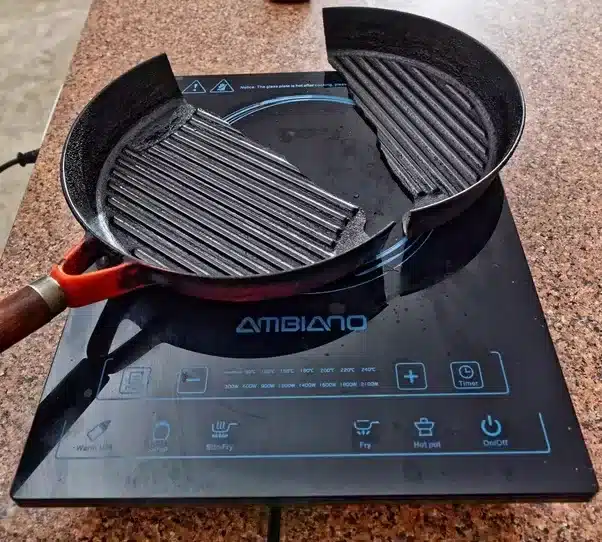
Can You Damage an Induction Hob by Using the Wrong Pans?
No, using the wrong pans won’t damage an induction hob. The hob won’t turn on or heat the pan if it isn’t magnetic. However, incorrect cookware, such as non-magnetic or improperly sized pans, can affect the hob’s functioning and cooking efficiency. Not all types of cookware are suitable for induction hobs, and using flat-bottomed, appropriately sized pans is crucial for optimal performance and to avoid potential issues.
How to Use Non-Induction Cookware on Induction Cooktops
Use an induction converter disk or adapter to make non-induction cookware compatible with induction cooktops. Non-induction cookware can still be placed on a magnetic induction converter disk, which attracts heat and allows the cookware to heat up.
Why Does Induction Work Differently With Different Pans?
The Importance of Ferromagnetic Materials Induction cooktops requires ferromagnetic cookware, which means the pan must contain iron. This is because only ferromagnetic materials can interact with the electromagnetic field produced by the cooktop. If your pan isn’t magnetic, the induction cooktop won’t be able to generate the heat required for cooking.
Thickness and Composition of the Pan The thickness and overall composition of the pan also play significant roles in how well it works with induction. Thicker pans typically heat more evenly because they distribute the electromagnetic energy better. However, they might take longer to heat up initially.
The Core Material Matters Pans with a magnetic core, such as those with a steel or iron core, perform better on induction cooktops than those with non-magnetic cores. Even if a pan has a magnetic exterior, the core may not heat as efficiently if it is made of non-ferromagnetic material.
Comparison of Common Pan Materials
| Pan Material | Induction Compatibility | Heat Efficiency | Notes |
| Cast Iron | Excellent | High | Heats slowly but retains heat well |
| Stainless Steel | Varies (if magnetic) | Moderate | Quality varies by brand and construction |
| Copper Core | Limited | High | It must have a magnetic base |
| Aluminum Core | Limited | High | Often combined with a magnetic exterior |
| Nonstick | Varies | Moderate | Check for a magnetic base |
| Ceramic | Poor | Low | Generally not compatible with induction |
Conclusion
Understanding pan compatibility with induction cooktops is crucial for efficient and safe cooking. Induction cooking uses electromagnetic fields to heat cookware directly, requiring pots and pans made from ferrous materials to function properly. Cookware must have a magnetic base to work on induction cooktops; otherwise, it will not heat up.
While cast iron and magnetic stainless steel are excellent choices for induction cooking, materials like aluminum, copper, and glass need a magnetic layer to be compatible. Non-induction cookware can be adapted using induction converter disks, which allow non-magnetic pans to work, though this may affect cooking efficiency.
To ensure optimal performance and avoid potential issues, always verify that your cookware is induction-compatible by performing a simple magnet test or checking the manufacturer’s specifications. With the right cookware, induction cooking offers precise control, rapid heating, and enhanced safety, transforming your kitchen experience.
Related Articles:
Why Do Induction Stoves Make Those Annoying Clicks? 2024
Which Induction Cooking Temperature is preferable? Info 2024
Is A 3500W Induction Burner An Overkill? Latest Info 2024
FAQs:
Q1: Can I use nonstick pans on an induction cooktop? Yes, but they must have a magnetic base. Not all nonstick pans are induction-compatible, so check the manufacturer’s specifications.
Q2: Why does my induction cooktop make a clicking sound with some pans? This can happen due to the pan’s material or thickness. It’s generally harmless but can be reduced using thicker, high-quality cookware.
Q3: Q4: How do I know if a pan is induction-compatible? Perform the magnet test—if a magnet sticks firmly to the bottom of the pan, it’s likely induction-compatible. Additionally, check the manufacturer’s label or specifications.

